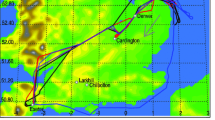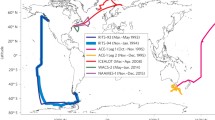Abstract
Observations taken by aircraft and conventional platforms are used to investigate dynamical, physical, and radiative processes within a marine stratus cloud during the Canadian Atlantic Storms Program (CASP) II field project which took place over the east coast of Canada. Stratus which formed over the ocean on February 6, 1992 during the nighttime, is studied to analyze cloud top and base processes. The cloud was supercooled during the study period. Fluctuations and fluxes are calculated along constant flight altitude legs approximately 100 km long in space. The scales of structures larger than 5 km are removed from the analysis using a running average technique. Droplet spectra obtained by a forward scattering spectrometer probe (FSSP) were used in a 1-D radiative transfer model to calculate infrared (IR) fluxes and radiative heating rates. A heat conservation equation was used to estimate vertical air velocity (w a ) within the cloud. The results showed that, because of a warmer ocean surface, significant moisture and heat were transferred from the ocean surface to the boundary layer. The cloud base was at about 400 m height and the top was at about 1.4 km.w a at the cloud base was estimated about 5 cm s−1. Strong IR cooling rate at the cloud top was calculated to be 75°C day−1 for a 100 m thick layer. Negative skewness inw a , suggesting narrow downdrafts, was likely due to radiative cooling at the cloud top. The entrainment velocity was found to be about 1.5 cm s−1 at cloud top. Mean moisture and heat fluxes within the cloud were estimated to be comparable to those from the ocean surface. Vertical air velocity at the cloud top due to radiative cooling was found to be about −40 cm s−1.
Similar content being viewed by others
References
Albrecht, B. A., Penc, R. S., andSchubert, W. H. (1985),An Observational Study of Cloud-top Mixed Layers, J. Atmos. Sci.42, 800–822.
Albrecht, B. A., Randall, D. A., andNicholls, S. (1988),Observations of Marine Stratocumulus Clouds during FIRE, Bull. Am. Meteor. Soc.69, 618–266.
Baumgardner, D., Strapp, W., andDye, J. E. (1985),Evaluation of the Forward Scattering Spectrometer Probe. Part II: Corrections for Coincidence and Deadtimes Losses, J. Atmos. Ocean. Tech.2, 626–632.
Blyth, A. M., Cooper, W. A., andJensen, J. B. (1988),A Study of the Source of Entrained Air in Montana Cumuli, J. Atmos. Sci.45, 3944–3964.
Brost, R. A., Lenschow, D. H. andWyngaard, J. C. (1982),Marine Stratocumulus Layers. Part I: Mean Conditions, J. Atmos. Sci.39, 800–817.
Caughey, S. J., Crease, B. A., andRoach, W. T. (1982),A Field Study of Nocturnal Stratocumulus Part II: Turbulent Structure and Entrainment, Q. J. R. Meteor. Soc.,108, 125–144.
Crawford, T. L., McMillen, R. T., andDobosy, R. J. (1993),Correcting Airborne Flux Measurements for Aircraft Speed Variations, Boundary-layer Meteorol.66, 237–245.
Deardorff, J. W. (1976),On the Entrainment Rate of a Stratocumulus-topped Mixed Layer, Q. J. R. Meteor. Soc.102, 563–582.
Deardorff, J. W. (1980),Stratocumulus-capped Mixed Layers Derived from a Three-dimensional Model, Boundary-layer Meteor.18, 495–527.
Fletcher, N. H.,The Physics of Rainclouds (Cambridge University Press 1962) 386 pp.
Foot, J. S. (1988),Some Observations of the Optical Properties of Clouds. II: Cirrus, Q. J. R. Meteor. Soc.114, 145–164.
Gultepe, I., Heymfield, A. J., andLenschow, D. H. (1990),A Comparison of Vertical Air Velocity in Cirrus Obtained from Aircraft and Lidar Measurements, J. Atmos. Ocean. Tech.7, 58–67.
Gultepe, I., andRao, G. C. (1993),Moisture and Heat Budgets of a Cirrus Cloud from Aircraft Measurements during FIRE, Q. J. R. Meteor. Soc.119, 957–974.
Gultepe, I. andStarr, D. O'C. (1994),Microphysical and Radiative Development of a Cirrus Cloud during FIRE: Implications for Dynamical Effects, J. Atmos. Res.34, 43–52.
Gultepe, I., andStarr, D. O'C. (1995),Dynamical Structure and Turbulence in Cirrus Clouds: Aircraft Observations during FIRE, J. Atmos. Sci., accepted.
Gultepe, I., Starr, D. O'C., Heymfield, A. J., Uttal, T., Ackermann, T., andWestphal, D. L. (1995),Dynamical Characteristics of Cirrus Clouds from Aircraft and Radar Measurements in Micro and Meso-γ Scales, J. Atmos. Sci., accepted.
Kinne, S., Ackerman, T. P., Heymfield, A. J., Valero, F. P. J., Sassen, K., andSpinhirne, J. D. (1992),Cirrus Microphysics and Radiative Transfer: Cloud Field Study on 28 December 1986, Mon. Wea. Rev.120, 661–684.
Lawson, R. P., andCooper, W. A. (1990),Performance of Some Airborne Thermometers in Clouds, J. Atmos. Ocean. Tech.7, 480–494.
Lilly, D. K. (1986),Models of Cloud Topped Mixed Layer under a Strong Inversion, Q. J. R. Meteor. Soc.94, 292–309.
MacPherson, J. I. (1990),Wind and Flux Calculations on the NAE Twin Otter, National Research Council Canada Report LTR-FR-109, 38 pp. Available from NRC, Ottawa, Canada, K1A 0R6.
MacPherson, J. I. (1993),Use of a Wing-mounted Airflow Pod for Airborne Wind and Flux Measurement, Proceedings of Eighth Symposium on Meteorological Observations and Instrumentation, Anaheim, January, 1993, Am. Meteor. Soc. 160–174.
Moyer, K. A., andYoung, G. S. (1991),Observations of Vertical Velocity Skewness within the Marine Stratocumulus-topped Boundary Layer, J. Atmos. Sci.48, 403–410.
Moyer, K. A. andYoung, G. S. (1993),Buoyant Forcing within the Marine Stratocumulus-topped Boundary Layer, J. Atmos. Sci.50, 2759–2771.
Nieuwstadt, F. T. M., andBusinger, J. A. (1984),Radiative Cooling near the Top of a Cloudy Mixed Layer, Quart. J. R. Met. Soc.110, 1073–1078.
Nicholls, S. (1984),Dynamics of Stratocumulus: Aircraft Observations and Comparison with a Mixed Layer Model, Q. J. R. Meteor. Soc.110, 783–820.
Nicholls, S., andLeighton, J. (1989),An Observational Study of the Structure of a Stratiform Cloud Sheets: Part I: Structure, Q. J. R. Meteor. Soc.112, 431–460.
Nicholls, S. (1989),The Structure of Radiatively Driven Convection in Stratocumulus, Q. J. R. Meteor. Soc.115, 487–511.
Nicholls, S., andTurton, J. D. (1986),An Observational Study of the Structure of Stratiform Cloud Sheets: Part II. Entrainment, Q. J. R. Meteor. Soc.112, 461–480.
Paluch, L. R., andLenschow, D. H. (1991),Stratiform Cloud Formation in the Marine Boundary Layer, J. Atmos. Sci.48, 2141–2158.
Roach, W. T., Brown, R., Caughey, S. J., Crease, B. A., andSlingo, S. (1982),A Field Study of Nocturnal Stratocumulus: I. Mean Structure and Budget, Q. J. R. Meteor. Soc.,108, 103–123.
Schubert, W. H. (1976),Experiments with Lilly's Cloud Topped Mixed Layer Model, J. Atmos. Sci.33, 436–446.
Siems, T. S., Bretherton, C. S., Baker, M. B., Shy, S. andBreidenthal, R. E. (1990),Buoyancy Reversal and Cloud-top Entrainment Instability, Q. J. R. Meteor. Soc.116, 705–739.
Slingo, A., Nicholls, S., andSchmetz, J. (1982),Aircraft Observations of Marine Stratocumulus during JASIN, Q. J. R. Meteor. Soc.108, 833–856.
Stage, S. A., andBusinger, J. A. (1981a),A Model for Entrainment into a Cloud Topped Marine Boundary Layer. Part I: Model Description and Application to a Cold-air Outbreak Episode, J. Atmos. Sci.38, 2213–2229.
Stage, S. A. andBusinger, J. A. (1981b),A Model for Entrainment into a Cloud Topped Marine Boundary Layer. Part II: Discussion of Model Behavior and Comparison with other Models, J. Atmos. Sci.38, 2230–2242.
Stephens, G. L. (1978),Radiation Profiles in Extended Water Clouds. Part II: Parameterization Schemes, J. Atmos. Sci.35, 2123–2132.
Stewart, R. E. (1991),Canadian Atlantic Storms Program: Progress and Plans of the Meteorological Components, Bull. Amer. Meteor. Soc.72, 364–371.
Stewart, R. E., andShaw, R. W. (1987),Canadian Atlantic Storms Program: The Meteorological Field Project, Bull. Amer. Soc.68, 338–345.
Stull, R. B., An Introduction to Boundary Layer Meterology (Kluwer Academic Publishers, The Netherlands 1988) 666 pp.
Sun, W. Y. (1993),Numerical Simulation of a Planetary Boundary Layer: Part II. Cloudy Case, Beitr. Phys. Atmosph.66, 17–29.
Author information
Authors and Affiliations
Rights and permissions
About this article
Cite this article
Gultepe, I. Physical, radiative, and dynamical processes within a nighttime marine stratus cloud. PAGEOPH 144, 321–350 (1995). https://doi.org/10.1007/BF00878638
Received:
Accepted:
Issue Date:
DOI: https://doi.org/10.1007/BF00878638




